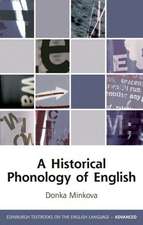Lexical Phonology and Morphology (RLE Linguistics A: General Linguistics): Routledge Library Editions: Linguistics
Autor Carole Paradisen Limba Engleză Hardback – 21 noi 2013
| Toate formatele și edițiile | Preț | Express |
|---|---|---|
| Paperback (1) | 416.22 lei 6-8 săpt. | |
| Taylor & Francis – 26 noi 2015 | 416.22 lei 6-8 săpt. | |
| Hardback (1) | 1006.92 lei 6-8 săpt. | |
| Taylor & Francis – 21 noi 2013 | 1006.92 lei 6-8 săpt. |
Din seria Routledge Library Editions: Linguistics
-
 Preț: 355.69 lei
Preț: 355.69 lei - 18%
 Preț: 1000.27 lei
Preț: 1000.27 lei - 18%
 Preț: 1003.93 lei
Preț: 1003.93 lei - 15%
 Preț: 672.58 lei
Preț: 672.58 lei - 18%
 Preț: 1004.72 lei
Preț: 1004.72 lei - 18%
 Preț: 1004.24 lei
Preț: 1004.24 lei - 18%
 Preț: 999.46 lei
Preț: 999.46 lei - 18%
 Preț: 779.13 lei
Preț: 779.13 lei - 34%
 Preț: 4327.12 lei
Preț: 4327.12 lei - 18%
 Preț: 1004.72 lei
Preț: 1004.72 lei - 15%
 Preț: 637.65 lei
Preț: 637.65 lei - 18%
 Preț: 1001.24 lei
Preț: 1001.24 lei - 34%
 Preț: 4048.76 lei
Preț: 4048.76 lei - 18%
 Preț: 1061.06 lei
Preț: 1061.06 lei - 18%
 Preț: 1063.89 lei
Preț: 1063.89 lei - 18%
 Preț: 783.10 lei
Preț: 783.10 lei - 18%
 Preț: 782.30 lei
Preț: 782.30 lei - 18%
 Preț: 891.85 lei
Preț: 891.85 lei - 18%
 Preț: 1001.84 lei
Preț: 1001.84 lei - 18%
 Preț: 1054.71 lei
Preț: 1054.71 lei - 18%
 Preț: 1003.12 lei
Preț: 1003.12 lei - 18%
 Preț: 1343.56 lei
Preț: 1343.56 lei - 18%
 Preț: 782.62 lei
Preț: 782.62 lei - 34%
 Preț: 5440.48 lei
Preț: 5440.48 lei - 18%
 Preț: 1002.80 lei
Preț: 1002.80 lei - 15%
 Preț: 672.90 lei
Preț: 672.90 lei - 18%
 Preț: 1003.93 lei
Preț: 1003.93 lei - 34%
 Preț: 2378.63 lei
Preț: 2378.63 lei - 18%
 Preț: 1061.84 lei
Preț: 1061.84 lei - 18%
 Preț: 1001.24 lei
Preț: 1001.24 lei - 34%
 Preț: 1821.92 lei
Preț: 1821.92 lei - 18%
 Preț: 1003.93 lei
Preț: 1003.93 lei - 18%
 Preț: 1285.04 lei
Preț: 1285.04 lei - 18%
 Preț: 1062.62 lei
Preț: 1062.62 lei - 18%
 Preț: 1061.06 lei
Preț: 1061.06 lei - 18%
 Preț: 781.82 lei
Preț: 781.82 lei - 18%
 Preț: 1058.69 lei
Preț: 1058.69 lei - 18%
 Preț: 1001.07 lei
Preț: 1001.07 lei -
 Preț: 330.87 lei
Preț: 330.87 lei - 18%
 Preț: 1169.78 lei
Preț: 1169.78 lei - 18%
 Preț: 1060.25 lei
Preț: 1060.25 lei - 18%
 Preț: 1002.02 lei
Preț: 1002.02 lei - 18%
 Preț: 1001.24 lei
Preț: 1001.24 lei - 18%
 Preț: 1287.89 lei
Preț: 1287.89 lei - 15%
 Preț: 673.09 lei
Preț: 673.09 lei - 18%
 Preț: 1956.17 lei
Preț: 1956.17 lei - 34%
 Preț: 1293.09 lei
Preț: 1293.09 lei
Preț: 1006.92 lei
Preț vechi: 1227.94 lei
-18% Nou
Puncte Express: 1510
Preț estimativ în valută:
192.68€ • 206.04$ • 160.65£
192.68€ • 206.04$ • 160.65£
Carte tipărită la comandă
Livrare economică 17 aprilie-01 mai
Preluare comenzi: 021 569.72.76
Specificații
ISBN-13: 9780415715812
ISBN-10: 0415715814
Pagini: 334
Dimensiuni: 156 x 234 x 19 mm
Greutate: 0.64 kg
Ediția:1
Editura: Taylor & Francis
Colecția Routledge
Seria Routledge Library Editions: Linguistics
Locul publicării:Oxford, United Kingdom
ISBN-10: 0415715814
Pagini: 334
Dimensiuni: 156 x 234 x 19 mm
Greutate: 0.64 kg
Ediția:1
Editura: Taylor & Francis
Colecția Routledge
Seria Routledge Library Editions: Linguistics
Locul publicării:Oxford, United Kingdom
Cuprins
Foreword. Preface. Overview. Acknowledgements. Abbreviations. Introduction. 1. Class Markers in Pulaar 2. The Vowel System 3. Consonants and their Status 4. The Sonority Constraint and Consonant Clusters 5. Syllables, Skeleton and w and y Variants. Conclusion. Bibliography. Lexicon. Pulaar-English Section. English-Pulaar Section
Descriere
This book presents a description of the phonology and morphology of the nominal class system in Fula, a dialect which displays 21 nominal classes. These are identified by suffixes, which can attach to nominal, verbal and adjectival stems. The main objective of this work is to show, through a lexical analysis, that there are only two monomorphemic marker variants, and that the distribution of these variants is predictable.

















